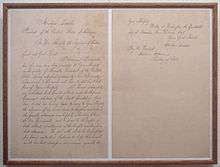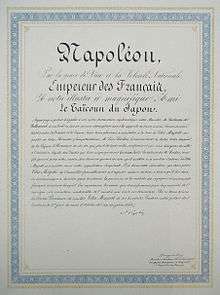Taikun
Taikun (大君) is an archaic Japanese term of respect derived from Chinese I Ching which once referred to an independent ruler who did not have an imperial lineage.[1] Its literal meaning is "Great Lord/Prince" or "Supreme Commander". In the Edo period, this word was used as a diplomatic title designating the shōgun of Japan in relations with foreign countries, as an attempt to convey that the shōgun was more important than the Japanese Emperor.[2] The official name is "Nihon-koku Taikun" (日本国大君, Tycoon of Japan).


The term was first used by the Tokugawa shogunate in an attempt to extricate Japan from the Sino-centric system of relations. As Shogun, he certainly could not call himself the Emperor of Japan (天皇, Tennō), but he also could not use the term "king" (国王, kokuō). As formal language is extremely important in diplomacy, the connotations of most alternative terms were found to be inappropriate, and so taikun was chosen to best represent the shogun in formal diplomatic communications.
A modified version of this word appears in the English language as tycoon,[3] referring to a wealthy business manager. The term is notable as a Japanese word in English that does not refer to Japanese culture.
References
- Wai-ming, Ng (2000). The I ching in Tokugawa thought and culture. University of Hawaii Press. p. 66. ISBN 978-0-8248-2242-2. Retrieved 2010-10-04.
- "tycoon". Dictionary.com. Retrieved 7 December 2015.
- Cummings, Donald Wayne (1988). American English spelling: an informal description. JHU Press. p. 277. ISBN 978-0-8018-3443-1. Retrieved 2010-10-04.